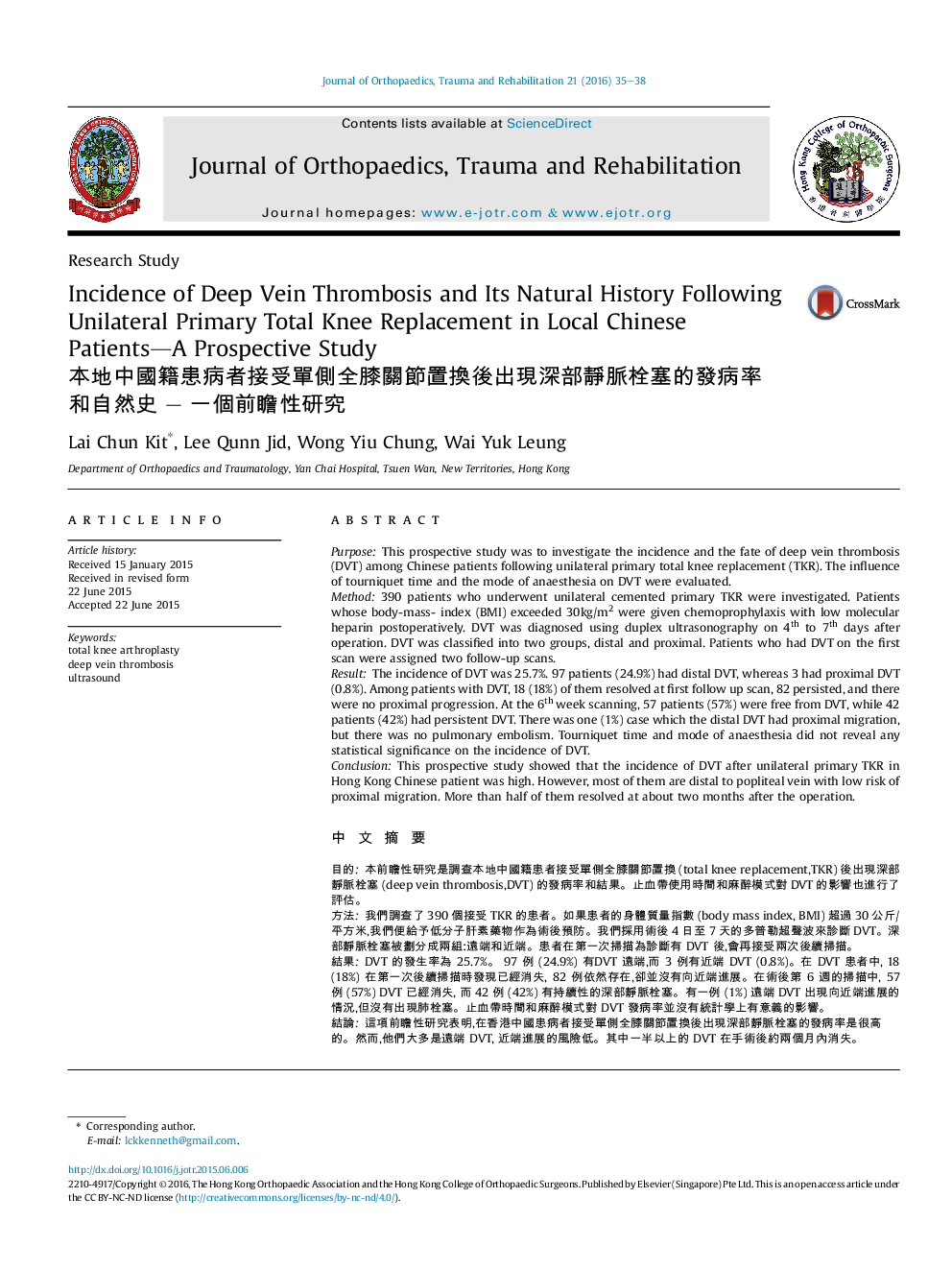| Article ID | Journal | Published Year | Pages | File Type |
|---|---|---|---|---|
| 4072522 | Journal of Orthopaedics, Trauma and Rehabilitation | 2016 | 4 Pages |
PurposeThis prospective study was to investigate the incidence and the fate of deep vein thrombosis (DVT) among Chinese patients following unilateral primary total knee replacement (TKR). The influence of tourniquet time and the mode of anaesthesia on DVT were evaluated.Method390 patients who underwent unilateral cemented primary TKR were investigated. Patients whose body-mass- index (BMI) exceeded 30kg/m2 were given chemoprophylaxis with low molecular heparin postoperatively. DVT was diagnosed using duplex ultrasonography on 4th to 7th days after operation. DVT was classified into two groups, distal and proximal. Patients who had DVT on the first scan were assigned two follow-up scans.ResultThe incidence of DVT was 25.7%. 97 patients (24.9%) had distal DVT, whereas 3 had proximal DVT (0.8%). Among patients with DVT, 18 (18%) of them resolved at first follow up scan, 82 persisted, and there were no proximal progression. At the 6th week scanning, 57 patients (57%) were free from DVT, while 42 patients (42%) had persistent DVT. There was one (1%) case which the distal DVT had proximal migration, but there was no pulmonary embolism. Tourniquet time and mode of anaesthesia did not reveal any statistical significance on the incidence of DVT.ConclusionThis prospective study showed that the incidence of DVT after unilateral primary TKR in Hong Kong Chinese patient was high. However, most of them are distal to popliteal vein with low risk of proximal migration. More than half of them resolved at about two months after the operation.
中 文 摘 要目的本前瞻性研究是調查本地中國籍患者接受單側全膝關節置換 (total knee replacement,TKR) 後出現深部靜脈栓塞 (deep vein thrombosis,DVT) 的發病率和結果。止血帶使用時間和麻醉模式對 DVT 的影響也進行了評估。方法我們調查了 390 個接受 TKR 的患者。如果患者的身體質量指數 (body mass index, BMI) 超過 30 公斤/平方米,我們便給予低分子肝素藥物作為術後預防。我們採用術後 4 日至 7 天的多普勒超聲波來診斷 DVT。深部靜脈栓塞被劃分成兩組:遠端和近端。患者在第一次掃描為診斷有 DVT 後,會再接受兩次後續掃描。結果DVT 的發生率為 25.7%。 97 例 (24.9%) 有DVT 遠端,而 3 例有近端 DVT (0.8%)。在 DVT 患者中, 18 (18%) 在第一次後續掃描時發現已經消失, 82 例依然存在,卻並沒有向近端進展。在術後第 6 週的掃描中, 57 例 (57%) DVT 已經消失, 而 42 例 (42%) 有持續性的深部靜脈栓塞。有一例 (1%) 遠端 DVT 出現向近端進展的情況,但沒有出現肺栓塞。止血帶時間和麻醉模式對 DVT 發病率並沒有統計學上有意義的影響。結論這項前瞻性研究表明,在香港中國患病者接受單側全膝關節置換後出現深部靜脈栓塞的發病率是很高的。然而,他們大多是遠端 DVT, 近端進展的風險低。其中一半以上的 DVT 在手術後約兩個月內消失。
